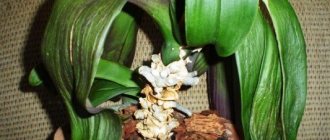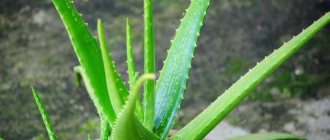Orchids are beautiful flowers that delight gardeners with their beauty and long-lasting flowering. Representatives of this family are beautiful all year round. Proper care ensures their health and development. Different types of orchids require different care. There are species that can be considered capricious, and there are also unpretentious beauties. Unfortunately, it is not always possible to preserve the health and beauty of a flower. The leaves of the plant may lose their elasticity and color saturation.
This article will discuss how to restore leaf turgor in an orchid.
What are the reasons why the leaves wrinkle?
To start saving an orchid, you first need to determine the reasons why the leaves have lost turgor and wrinkled. There may be several of them.
- Overheating of the root system, which can occur due to the location of the pot being too close to heating devices or constant exposure of the flower to direct sunlight. As a result of overheating, the roots no longer receive enough moisture, which leads to lethargy of the plant.
- Another reason for the loss of turgor is too dense soil, due to which the roots do not have enough fresh air. That is why experienced gardeners recommend replanting the plant every 2-3 years to prevent caking and compaction of the soil.
- Lack of moisture. The air humidity in the room and in the orchid pot should always remain approximately the same level. In addition, if the leaves are not wiped with a damp sponge, dust will accumulate on them and photosynthesis will be disrupted. As a result, the top layer of leaves begins to dry out and then gradually wrinkle.
- High humidity. Excessive watering also does not have the best effect on the turgor of the orchid. If the soil is constantly wet, this can lead to root rot, which leads to wilting of the leaves.
- Excess of minerals. Orchids need feeding to grow roots, restore strength after flowering, or to adapt to new conditions. Often, fertilizers are applied along with watering, but sometimes the amount of nutrients can be overdone. Fertilizers, like salt, begin to be deposited in the substrate, on the roots of the plants and the walls of the pot, which leads to injuries and even burns to the plant.
- Diseases. If the orchid leaves not only begin to wrinkle and fade, but also dark, light spots, streaks or stripes appear on them, this indicates various diseases. The most dangerous are viral diseases that lead to the death of the plant.
What to remember about frostbite in orchids? Effect of low temperatures
At low temperatures, the orchid is quite capable of getting frostbite on the leaf mass. If the roots are not affected, then the grower has the opportunity to revive the flower. If the plant is completely damaged, then it can no longer be saved.
Causes of frostbite:
- First of all, this is buying a flower in the cold season without packaging or with insufficient packaging without a car, where you can quickly get after leaving the store;
- Cold air in the room where the flower is cultivated. After all, a temperature of +16 degrees is considered quite cold, and watering at this temperature will lead to the death of the flower;
- Winter drafts. Orchids located in their path freeze very quickly, especially after watering.
As already mentioned, if the flower is completely frostbitten, it cannot be saved, but if it is a small area on the leaf blade, it is cut off with scissors and the sections are treated with an antiseptic. If part of the trunk is affected by frostbite, then:
- All foliage is cut off;
- And the cut area is sprinkled with charcoal.
In this case, you will have to wait for the baby to appear at the edge of the trunk. Sometimes the wait lasts up to six months, it all depends on the vitality of the bush.
Causes of lethargy
Container phalaenopsis require a lot of attention from the gardener. At the slightest violation of care, the flowers begin to hurt. Orchid leaf plates can lose their elasticity for various reasons, the main ones being the following:
- Dying of roots. The orchid does not receive enough moisture, the leaves wrinkle, turn yellow and become lethargic.
- Natural aging. The trunk leaf lives up to 3 years, then it gradually dies.
- Frostbite or overheating. In both cases, the foliage becomes lethargic.
- Inappropriate fertilizers or incorrect concentration when fertilizing. Most likely, the root system has been burned and therefore the leaves do not receive enough moisture to maintain their turgor.
- Damage by pests or diseases. If this is really the case, delay threatens the death of the flower. It is urgent to use insecticides (if the presence of harmful insects is noticed) or fungicides (when there are signs of disease).
- Insufficient hydration. Not only does the foliage fade, but the development of the peduncle may slow down. With a critical lack of watering, it dries out completely.
https:///wp-content/uploads/2018/07/narushenie-turgora
On a note!
The loss of turgor by the leaves, if these negative changes in the state of the phalaenopsis orchid were noticed in time, is a reversible process.
Options for restoring turgor
Currant leaves
If the leaves of the plant have become limp as a result of lack of moisture, then restoration will not require complex actions. In this case, you should adjust the watering schedule and, during particularly hot periods, additionally spray the upper part. It is recommended to moisten Phalaenopsis once a week by immersing the pot halfway in a container of warm water. The duration of watering is 2 hours. This will allow not only the roots to be saturated with moisture, but also the substrate.
Important! After watering the plant if there is a lack of moisture, turgor returns to the leaves on the third day.
It is necessary to water phalaenopsis using the soaking method.
If the plant begins to wither not due to lack of water, then the root system should be examined. To do this, you need to carefully remove it from the pot and examine all the shoots. If necessary, dry areas should be trimmed and open wounds should be sprinkled with cinnamon or charcoal. After this, you need to plant the crop in a new substrate and water the plant with any root-forming agent.
If the loss of turgor is caused by sunlight or heating devices, it is necessary to move the pot with phalaenopsis to another place with favorable conditions for its growth.
Important! To quickly restore elasticity, it is recommended to additionally wipe the upper surface of the leaves with a solution of succinic acid
Examples after transplant
If after transplantation an orchid loses leaf turgor, what to do in this case? You need to restore elasticity gradually. The transplanted plant must be removed to a semi-dark place for several days, since its root system has not had time to fully recover after the procedure and cannot fully provide the leaves with moisture. Therefore, it is necessary to reduce its evaporation at first.
The presence of a peat cup with compacted sphagnum moss in a purchased flower can also provoke a loss of turgor. Therefore, it is necessary to immediately examine the plant and remove it, subsequently treating the root system with crushed activated carbon. In this case, turgor will return to the leaves gradually when the root system is completely restored.
How to restore greenery and restore its elasticity?
Having noticed a loss of turgor, it is necessary to begin rehabilitation measures.
- First of all, it is necessary to conduct a thorough inspection of the plant for the presence of diseases. If any disease manifests itself, then you need to start treatment.
- If upon examination it turns out that there are no diseases, it is necessary to remember when the plant was last watered, sprayed and fed. It happens that the plant simply does not have enough water or useful minerals. In this case, it is necessary to move the pot away from the heat source and organize a watering schedule.
- Watering and fertilizing are carried out according to schedule, but the plant still loses turgor? In this case, it is worth inspecting the roots of the orchid, which may be rotting due to a cramped pot or too dense soil. In this case, you need to get the plant and cut off the rotten roots.
After this, the sections are treated with activated carbon, and the soil is replaced.If the roots are very damaged, you can use drugs that stimulate their growth. The leaves can be wiped with succinic acid, and if they dry out too much, it can be added to the water for irrigation.
What to do: step-by-step instructions
It is important not only to understand why the plant’s foliage becomes soft and limp, but also to know what to do next. If the grower notices a decrease in the turgor of the flower part of the flower, measures will need to be taken to restore the plant
Inspection of the plant
You should carefully inspect the ground part. It should not contain:
- no raid;
- yellow or brown spots.
If there are any, the orchid is sick. The root system must be carefully inspected. It should have a uniform color without interspersed black and brown spots.
Trimming roots and damaged leaves
All damaged leaves and roots must be removed. You should not be afraid of harming the flower, since fungi and infections actively multiply and live in these places. All cut areas must be treated to prevent harmful organisms from entering the stem and root system through them.
Disinfection is carried out with industrial antiseptics without alcohol or by sprinkling with cinnamon and activated carbon.
The cut areas should be treated until the wound is completely healed and the plant recovers from the manipulations.
Transplanting into a new pot and substrate
To completely remove traces of rot and all bacteria from the plant, it needs to be transplanted into a new pot. Beforehand, be sure to soak the new container in a soapy solution for several hours.
Before planting, it is recommended to soak the roots for 30-60 minutes in a solution of 0.1% succinic acid.
The soil for planting should be loose and well moistened. When watering new soil, it is recommended to add the required dose of fungicides, which will not only protect the plant from fungi and infections, but will also provide good nutrition and support the orchid’s immunity.
The best fungicidal drugs are:
- Maksim.
- Alirin.
- Fitolavin.
- Vitaros.
- Fundazol.
The flower should be placed carefully so as not to break the delicate roots.
After transplantation, the plant may get sick, so you should provide it with the most comfortable conditions without direct sunlight and drafts.
Care
If the leaves of an orchid are wrinkled, then something should be done urgently. Most of the problems are related to improperly organized care for the beauty.
Nice leaf of variegated Phalaenopsis
This is about:
- Watering. It is important to choose the correct frequency of soil moisture, because mistakes lead to excess moisture or excessive drying. Usually water the flower no more than once every 7 days. However, it is best to check the soil either by touch (it should be barely damp) or by visual reference. If there is condensation on the walls of the container, then it is too early to water. Wrinkles will not appear if you carefully monitor your beauty.
- Temperature and lighting. Orchids do not like direct sunlight. This leads to burns and overheating of the substrate. The plant is ideally suited to diffused lighting and shading. During the day, temperatures should not rise above +28 °C, and at night they should not fall below +17 °C. The daily temperature difference is very important. Typically, the difference between day and night readings is about 5-7 degrees Celsius. If you organize everything correctly, then the wrinkled leaves of the orchid will not be a threat.
Important! If the flower does not have enough moisture, then you can organize another source. To do this, place a container of water next to the pot.
The main reasons for orchid lethargy
One of the main reasons for the lethargy of Phalaenopsis orchid leaves is improper care. However, this should not always be a reason to take serious action, since the appearance of a few wilted leaves is often a sign of rejuvenation of the plant. Old foliage periodically fades, and is replaced by young green leaves.
But if the stem loses density, the leaves wither and become dry and wrinkled, the flower needs to be urgently revived.
Before taking rescue measures, the cause of turgor should be determined. There may be several of them:
- bacterial and fungal infections;
- lack of moisture;
- problems with roots;
- violation of fertilizer concentration.
Having established the exact cause that contributes to the wilting of foliage, appropriate measures should be taken.
Phalaenopsis wrinkles due to overheating of roots
For most types of orchids, the optimal air temperature during the day is +18-28 °C, at night - at least +13 °C. Heating devices and exposure to direct sunlight increase the air temperature, heating the substrate, which contributes to overheating of the flower.
This leads to the following manifestations:
- loss of moisture;
- loss of elasticity;
- wrinkled leaf surface;
- rarely – plant burn.
Important! If the roots overheat, the flower experiences stress. The rhizome loses moisture due to increased evaporation, which leads to drying out of the root system. An orchid, experiencing a lack of moisture, feeds it from the foliage, and accordingly, it begins to fade.
Loses density due to improper soil
The reason for the violation of turgor is often too dense soil. As a rule, the flower is planted in flowerpots filled with a special nutrient substrate.
It consists of the following components:
- sphagnum;
- crushed bark of coniferous trees;
- vermiculite;
- charcoal;
- pebbles, small stones.
The substrate has a loose structure due to the fact that all components do not fit tightly to the roots. This promotes good air circulation and enriches the root system with oxygen.
If the soil is rarely changed, the components are crushed, filling all the empty spaces. The substrate becomes dense, does not retain moisture well and does not have time to dry completely. In addition, dense soil causes the proliferation of putrefactive bacteria and infections that adversely affect the root system.
Attention! Poor-quality soil may contain insufficiently boiled coniferous tree bark containing resins. This can also cause the development of various bacteria and lead not only to depletion of the rhizome, but also to the death of the plant.
Lost moisture due to insufficient watering
If the Phalaenopsis orchid is watered frequently and excessively, it suffers from the harmful effects of various fungal microorganisms. In the same way, this negatively manifests itself in the case of insufficient watering. Most often, such problems arise in the summer, when at high temperatures, gardeners try to increase the volume and number of waterings. Such actions are unacceptable!
Air and soil humidity are important to ensure normal orchid growth. The ideal option is if their level does not change dramatically.
If this balance is disturbed, then a disturbance occurs in the process of photosynthesis, as well as:
- the substrate dries;
- the root system does not receive the required amount of moisture;
- the top layer of leaves dries;
- turgor decreases.
If the soil is not moistened for a long time, the roots dry out, the plant weakens and becomes exhausted, which leads to a decrease in turgor.
Important! It is not recommended to increase the number of waterings. You can satisfy the plant's need for moisture by spraying. During this process, it is necessary to completely remove water from the sinuses. Otherwise, the leaves will wrinkle and begin to rot.
May disappear due to excessive feeding
The root system of orchids is sensitive to excess fertilizer. Its frequent use or significant excess of the concentration recommended by the manufacturer is unacceptable. This can cause large amounts of mineral salts, phosphorus and potassium to enter the soil. These components actively affect the rhizome, as a result of which it begins to dry out.
The state of the root system directly affects the above-ground part of the crop, so all the processes occurring in it affect its appearance. When it loses viability, the following changes may occur to the leaves of the flower:
- they turn yellow;
- lose turgor;
- dry up.
Attention! Concentrated fertilizers do more harm to the plant than good. Their oversaturation with active substances negatively affects the flower. When choosing a fertilizer, you should purchase a special composition that bears the inscription “For orchids.” Such fertilizers contain a balanced amount of substances that are beneficial specifically for a given crop.
The growing point has turned black and the leaves have withered
Of particular concern to gardeners is damage to the growing point of monopodial orchids, since it is found in only one specimen.
Its blackening is usually caused by physical damage, burning in the bright sun, bacterial or fungal infections, or water entering and remaining in the core for a long time.
The result depends on the degree of damage and the chances of salvation are 50/50.
After damage to the growing point, the leaves will naturally begin to wither due to the blocking of food access. The “rosette” will not grow, and the orchid may begin to multiply, that is, form children from meristems located on the peduncle or meristems on the stem.
Sooner or later they will grow, especially if they are helped in this by using hormonal cytokinin paste.
This option of rescue, with the subsequent separation of the baby, has a chance of existence if there is a dormant kidney or kidneys. Otherwise, the leaves may remain limp for some time, but will gradually begin to turn yellow and eventually dry out completely.
If at least a small part of living tissue remains at the growth point, then the orchid can be reanimated. True, it will take too long to fully restore it.
Adviсe
In unusual circumstances, classical recommendations will not help. But even for such situations, there are tips that allow you to restore both turgor and the orchid itself:
- If there are no roots, this is a risky method. Turgor will be restored in a few days if a small section of the stem is immersed in water for several days. Throughout this time, you need to monitor the condition of the plant and its reaction.
- When there are no roots, this is a less risky method. The stem is placed above a nutrient solution - water with fertilizing or a biostimulant. The method will allow you to quickly grow roots and restore turgor.
- If there are not enough roots. It happens that on the 3rd day after watering, the turgor of phalaenopsis becomes worse. This happens because the root system, due to its insufficient size, is unable to provide both the trunk and foliage with nutritional compounds and moisture. In this case, use a root formation stimulator or cut off 2-3 lower leaf blades.
- When the orchid blooms. This happens due to excessively infrequent watering. Correct the situation with a warm shower or watering by immersing the plant in water with a low concentration of fertilizer.
Attention!
Removing leaf plates is only permissible in a situation where there are more than 6 of them per stem.
The phalaenopsis orchid is a rather demanding plant, but it immediately makes it clear that something is wrong with its care. If a flower's condition deteriorates, it is immediately visible - the turgor of the leaves worsens. In this case, all that remains is to calculate the cause of the lethargy of the leaf plates and eliminate it. In this case, if everything is done correctly, the turgor of the leaves of the phalaenopsis orchid will be restored, as well as the health of the plant itself.
Prevention
It is better to prevent any disease than to treat it. The same applies to restoration procedures for turgor of phalaenopsis leaves.
In order not to waste a lot of time and effort on putting the trunk in order, you just need to care of it responsibly
Water in a timely manner;
For prevention purposes, it will also be effective to regularly spray the trunk and water it with a warm shower.











